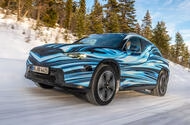The new Mercedes-Benz GLC EV is set to make waves in the electric vehicle market, stepping in as an indirect replacement for the EQC SUV. This shift marks a significant change in Mercedes’ approach to electric vehicles, moving towards a strategy that emphasizes integration rather than creating entirely separate models for different powertrains. So, what does this mean for car enthusiasts and potential buyers?
A Unified Look and Feel
One of the standout features of the GLC EV is its design. It will closely resemble the facelifted version of the combustion-engine GLC, which means that buyers can expect a familiar aesthetic both inside and out. This cohesive design philosophy is part of CEO Ola Källenius’s vision to streamline the brand’s offerings, making it easier for consumers to transition between electric and traditional vehicles. The hope is that by leveraging the established popularity of the GLC nameplate—one of Mercedes’ best-sellers since its launch in 2015—the GLC EV can significantly boost the company’s electric vehicle sales.
This approach not only simplifies production and development but also helps cut costs as Mercedes ramps up its electric vehicle lineup. The GLC EV is just the beginning; it will be joined by the next CLA, which will also follow this integrated strategy.
Power and Performance
The GLC EV is built on Mercedes’ new MB.EA platform, designed specifically for electric vehicles. This platform will also support future models, including electric versions of the C-Class and a compact off-roader akin to the G-Class. Under the hood, the GLC EV will feature the eATS 2.0 drivetrain, which promises impressive performance. In its most powerful configuration, it will deliver up to 483 horsepower, while a more modest single-motor variant will produce 268 horsepower.
Powering this performance is a robust 94.5 kWh battery, which is expected to provide a range of over 404 miles on a single charge. Plus, with a new 800V electrical architecture, charging speeds can reach up to 320 kW, allowing for a remarkable 162-mile range in just 10 minutes of charging. This kind of efficiency is a game-changer for those who are always on the go.
Innovative Features for Enhanced Efficiency
Mercedes has also introduced a new heat pump that is not only more effective than previous systems but also more compact, allowing for additional storage space. The GLC EV boasts a 100-liter front trunk (frunk) in addition to a spacious 560-liter rear boot, surpassing the luggage capacity of the current ICE GLC model.
Another exciting innovation is the One Box brake energy recuperation system. This advanced system decouples the brake pedal from the physical braking mechanism, using computer calculations to determine how much regenerative braking versus traditional braking is needed. Dominik Voogdt, head of overall vehicle engineering for the GLC EV, describes this as a “game-changer” for efficiency, and early tests suggest it significantly enhances the driving experience.
Real-World Testing: Galtispuoda Pass
To put the GLC EV through its paces, Mercedes took it to the Galtispuoda mountain pass in Sweden, a challenging route known for its steep inclines and unpredictable surfaces. The conditions were far from ideal, with snow and ice testing the vehicle’s traction and handling. However, the GLC EV rose to the challenge, showcasing its impressive four-wheel-drive system and driving assistance technologies.
Despite the slippery conditions, the GLC EV maintained excellent traction and acceleration. The stability control system worked seamlessly in the background, ensuring a smooth and controlled ride. The steering felt precise, providing ample feedback and inspiring confidence, even in tight corners. Mercedes’ engineers have fine-tuned the rear-wheel steering system, enhancing agility and responsiveness.
What truly stood out during the drive was the vehicle’s ability to handle braking. The regenerative braking system was so effective that it often brought the car to a complete stop without engaging the physical brakes. This not only enhances efficiency but also contributes to a smoother driving experience.
Production and Availability
The GLC EV will be produced at Mercedes’ facilities in Bremen, Germany, and Beijing, China, with potential additional production in Tuscaloosa, Alabama, depending on tariff considerations. The vehicle is expected to make its debut at the Munich motor show, with a UK launch anticipated in early 2026.
The big takeaway? The GLC EV isn’t just about being an electric alternative; it represents a smarter evolution in how Mercedes approaches electric mobility. By blending familiar design with cutting-edge technology, the GLC EV is poised to attract both loyal Mercedes fans and new customers looking for an efficient, high-performance electric vehicle. If you’re considering making the switch to electric, keep an eye on this model—it could very well set the standard for what’s to come.

